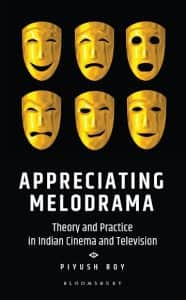Melodrama, as an art form, has a rich history that continues to captivate audiences worldwide with its emotional intensity and dramatic storytelling. It encompasses various mediums, including literature, theatre, film, and music. Shifting our focus to Indian melodrama, often referred to as “masala films” we find a genre that holds a unique and cherished place in Indian cinema. Known for its larger-than-life storytelling, emotional intensity, vibrant musical numbers, and dramatic performances, Indian melodrama has captivated audiences for decades. Thus, we understand the significance of ‘Melodrama’ lies in its ability to resonate with a broad audience by tapping into universal emotions. In the book Appreciating Melodrama: Theory and Practice in Indian Cinema and Television by Piyush Roy, the author explores and acknowledges the enduring impact of the ancient Sanskrit drama treatise, the Natyashastra, and its aesthetics theory, the ‘Rasa’ theory, on the distinctive narrative elements found in Indian cinema. The book delves into the rich tradition of melodrama in Indian storytelling, highlighting how the principles outlined in the Natyashastra have shaped and influenced the emotional and aesthetic aspects of Indian films and television. [caption id=“attachment_13069732” align=“alignnone” width=“472”] Appreciating Melodrama Theory and Practice in Indian Cinema and Television by Piyush Roy
Appreciating Melodrama Theory and Practice in Indian Cinema and Television by Piyush Roy
Published by: Bloomsbury.
Price: INR 1299 (Hardcover)[/caption] Central to the book’s analysis is the use of the ‘Rasa’ theory, encompassing the ‘Navrasas’ Bhavas/ Anubhavas (feeling/mood/sentiment/expression). This approach places a significant emphasis on character depiction in popular films, which have resonated with Indian and international audiences over time. The foundation of Rasa/Bhava theory showcases the authenticity and integrity of culture-specific creativity and practice, problematizing established ideas of Western binarism and underscoring the validity and appeal of Indian cinema. Notably, the book maintains a balanced argument, avoiding the tendency to either demonise or overvalorize Indian Cinema. The book challenges the Western perspective that often labels Indian films as ‘melodrama’ and offers a fresh perspective on the cinematic traditions of Indian Cinema and television. By subverting the Western ‘standard’ of appraisal, the author of the book Piyush Roy highlights the importance of understanding Indian cinema on its own terms, within its cultural context. It draws from the theoretical framework provided by the ancient Indian Natyashastra, attributed to the sage Bharata, which is centuries old. This approach allows for a deeper appreciation and analysis of the continuity in Indian dramatic modes throughout the history of Indian cinema. A key aspect of Indian melodrama is its ability to strike a chord with viewers by tapping into their emotions. These films often explore themes of love, family, honour, sacrifice, and societal issues, presenting them in an exaggerated and emotionally charged manner. The heightened emotions depicted on-screen aim to evoke strong reactions from the audience, creating a sense of catharsis and escapism. This pioneering work of Piyush Roy opens new avenues for understanding and appreciating Indian cinema, offering fresh insights into its emotional and narrative depth while challenging dominant paradigms in film criticism. The book’s chronological study of landmark films from both Mumbai and regional cinema showcases the evolution and enduring appeal of Indian films, not only in the subcontinent but also among global audiences. By providing insights into the development of Indian cinema over the years, the book also exemplifies the cultural significance and international success of Indian films. This comprehensive work also critically examines a diverse selection of landmark films spanning 100 years of Indian cinema, representing various genres, regions, and languages. It introduces a groundbreaking approach to the academic analysis of popular Indian cinema by employing the Indian aesthetic appreciation theory of ‘Rasa’ as a framework. Through case studies, the book presents a rigorous academic review of popular Indian films, particularly those in the melodramatic genre. By doing so, it challenges the prevailing First World/Euro-American film criticism canons that prioritise cinematic ‘realism’ over alternative narrative forms. “Appreciating Melodrama” by Piyush Roy also sheds light on the richness and complexity of Indian cinema and television, moving beyond Western preconceptions and showcasing the value of embracing Indian aesthetic traditions to understand and appreciate these captivating storytelling forms. The volume proposes a novel theoretical model for film appreciation, emphasising the significance of emotional resonance and affective storytelling in Indian cinema. This new perspective is likely to spark passionate debates among scholars and researchers in the field of film studies, as it questions established conventions and explores the value of diverse narrative approaches. This book is a timely and significant contribution to the field of film studies. The impact of Indian melodrama on Indian cinema and culture has been immense. It has been a dominant genre for decades and has influenced the way stories are told in Indian films. Many iconic films and performances have emerged from this genre, leaving a lasting imprint on the industry. The book highlights the connections between diverse performance art forms, such as traditional regional theatre and national television epic series, solidifying the position of silver and small screen productions as integral to Indian aesthetic perception and response. It adeptly draws parallels between parallel cinema and the popular masala film industry, distinguishing between cognitive realism and effective realism, thereby affirming the efficacy of Indian melodrama and its enduring appeal from pre- to post-Independence times. This book is an indispensable academic reference for students studying film and theatre, encompassing diverse subjects like world cinema, Indian cinema studies, South Asian studies, and cultural studies. It also holds significance in the field of Indology and the ‘Sociology of Cinema’ studies. It is a must-have resource in the curriculum of practical-oriented acting schools, as well as courses and modules that delve into the theoretical aspects of cinema, such as film criticism, film appreciation, the history of movies, and performance studies. In conclusion, ‘Indian melodrama’ exemplifies the power of emotional storytelling in their respective domains. It continues to shape and enrich their respective artistic landscapes, proving the enduring appeal and significance of this expressive art form. The reviewer is a Bengaluru-based management professional, literary critic, and co-director of the Kalinga Literary Festival. He can be reached at
ashutoshbthakur@gmail.com
. Views expressed in the above piece are personal and solely that of the author. They do not necessarily reflect Firstpost_’s views._ Read all the
Latest News
,
Trending News
,
Cricket News
,
Bollywood News
, India News
and
Entertainment News
here. Follow us on
Facebook
,
Twitter
and
Instagram
.
Book Review | Appreciating Melodrama: Challenging Western perceptions Piyush Roy offers a fresh view on Indian cinema
Ashutosh Kumar Thakur
• September 2, 2023, 16:35:08 IST
Through case studies, the book presents a rigorous academic review of popular Indian films, particularly those in the melodramatic genre
Advertisement
)
End of Article